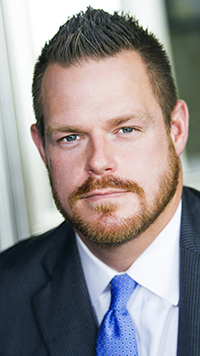'Bluff City Law' takes on the 'American epidemic' of opioid abuse

A still from the “American Epidemic” episode of Bluff City Law, with William Connell (left to right) as Jason Glassman, Caitlin McGee as Sydney Strait, and Jimmy Smitts as Elijah Strait. Photo by Katherine Bomboy/NBC.
One of my best friends growing up in Western Oklahoma recently accomplished his first full year of sobriety. We had kept in sporadic contact over the last decade or two, and every time we spoke, it was like nothing had changed. That is, until something did. I knew he was hurting, but I didn’t know exactly how bad his situation was. He had become addicted to prescription pain pills, and that addiction slowly progressed to heroin. He hit rock bottom, but he’s doing well now.
They say art imitates life, so I wasn’t surprised to see a commercial for a new episode of NBC’s Bluff City Law dealing with the opioid epidemic right about the same time my friend’s first year of sobriety was rolling around. That development, along with a recent landmark legal case here in Oklahoma, convinced me to tune into the episode, titled “American Epidemic.”
Earlier in 2019, Oklahoma became the first state to pursue a jury verdict against a major drug manufacturer for the destruction wrought by the pills they produced. A judge in Cleveland County, Oklahoma, ordered Johnson & Johnson to pay the state $572 million in damages (later reduced to $465 million in the judge’s final order) for “intentionally play[ing] down the dangers and over[selling] the benefits of opioids.”
Ultimately, Johnson & Johnson was found to have violated the state’s “public nuisance” law. Never before had a state taken a tort claim of this sort, against such a significant participant in the prescription-painkiller playing field, all the way to jury trial. Oklahoma knew it had its hands full, seeing as how it had already collected pretrial settlements in the amounts of $85 million and $270 million against two other drug manufacturers that produce opioids.
Regardless, Oklahoma’s victory has provided a blueprint for more than 2,000 other lawsuits by states and cities across the country levied against drug manufacturers. Nevertheless, the broader focus of many law enforcement agencies is to continue cutting off the limbs of the distribution tree, while the roots remain intact, for now.
‘American Epidemic’
“American Epidemic” is the 7th episode in the series’ first season. I haven’t watched Bluff City Law before, so this episode is all I’m basing my assessment on. The premise isn’t entirely interesting, and the story feels like a retread at best. There is a somewhat compelling family dynamic at play, but it gets lost in the attempts at procedural posturing.
The installment in question finds the protagonists going after a pill mill proprietor who has ushered a small Tennessee town into an epidemic of addiction. The show’s father-daughter duo gets temporarily sworn-in as assistant prosecutors to head the charges against the doctor accused of providing the pills.
When one of his patients dies of an opioid overdose, the case against him seems clear. However, the audience quickly discovers that the patient actually died from abusing heroin, and the protagonists are forced to reassess the path toward prosecution.
When Victims Become Defendants
Although the approach was touch-and-go, “American Epidemic” at least did an admirable job of broaching the downward spiral prescription drug abuse can cause. Many people fail to realize that prescription drug abuse often brings about addiction to other drugs. Folks are more than happy to trot out the old allegation that marijuana is a “gateway” drug, but very rarely do we hear that prescription medication is just as much, if not more, of a gateway drug than the devil’s lettuce.
I’ve seen it more times than I can count. An individual walks into my office with a criminal case for possession of a controlled dangerous substance. We talk about the who, what, where, when and why. The “why” stems from an injury that occurred through sports or maybe on the job. Perhaps it’s a degenerative issue that has worsened over time. Whatever the “why” though, these people were prescribed high doses of heavy painkillers.
They become addicted to the pills, and once the physician pulls the prescription, the patient is forced to rely on the streets to find that same relief. They begin by buying prescription pills from a friend or a friend of a friend. They soon realize that paying a black-market price for the medication without health insurance adds up quickly. Sooner or later, they can’t find enough pills to feed the addiction regularly. Others figure out that their pocketbooks can’t keep up with the demand. Consequently, they move on to a cheaper, more widely available drug, such as heroin.
Even those who can keep up with the costs of their medications run into problems. If a person is able to pay the asking price for their prescriptions, then we have to assume there is still some physician supplying those prescriptions (and accepting insurance). It’s not out of the ordinary for these patients to continue taking the medications that their physician keeps prescribing, all the while becoming more and more dependent and addicted. Some patients may not have any personal or family experience with addiction, or they may simply be relying on the advice of the doctor they trust to treat them. Then come the charges for driving under the influence of drugs, as they fail to recognize the degree to which their medication affects their ability to operate a motor vehicle. They are lucky if they (and everyone else on the road) survive the drive that leads to the eventual stop.
Establishing Liability … Who’s to Blame?

William Connell (left) plays Jason Glassman, a man whose wife died after she developed an opioid addiction. Jimmy Smitts plays his attorney, Elijah Strait. Photo by Katherine Bomboy/NBC.
The counterpoint? It’s difficult to expect medical professionals to know if and when their patients are abusing medications. I’m not aware whether medical doctors receive any generalized training on addiction detection. It’s not hard to spot a junkie, but no one starts out that way. Plenty of people who end up in the throes of bottom-barrel addiction lead lives that outwardly appear fine and dandy. Often, it’s too late by the time anyone becomes aware of the issue.
Consequently, if medical doctors use education, discretion and detection when prescribing medications, it’s difficult to argue they are criminally culpable for their patients’ actions. I like to believe that the majority of medical professionals have their clients’ best interests in mind. There are definitely others, though, who are more worried about their bottom line—at any cost. Those practitioners are the ones willing to overprescribe medications, or even hand out unnecessary prescriptions, if it means more money in the bank. Nevertheless, as the episode in question illustrates, it is sometimes difficult to establish criminal liability against the individuals who prescribe these medications.
One Ohio doctor was recently sentenced to seven years in federal custody due to her role in distributing controlled dangerous substances from her “pill mill”—a name often attributed to facilities that see multiple clients daily for pain management. These pill mills specialize in prescribing scheduled substances to individuals for a price, and the focus seems to be on “treating” as many patients as possible as opposed to giving individualized attention to the actual person and their specific condition.
Another offender in Dallas received a 13-year federal sentence after he was convicted of conspiracy to distribute a controlled dangerous substance following a five-day trial. According to the DEA, Carlos Luis Venegas “oversaw the illegal prescription of nearly a million units of narcotics with no legitimate medical purpose”—and the conspiracy was far-reaching. “At trial, witnesses testified that members of the conspiracy paid homeless and indigent people to pose as patients seeking pain medication. Runners coached these men and women on how to describe their (nonexistent) symptoms, drove them to the clinics, and paid for their appointments.”
But even a 13-year sentence pales in comparison to the 4-years Dr. Joel Smithers of Virginia received following his conviction for more than 800 federal drug charges after trial in the Western District of Virginia. Forty years is on the harsher side of sentences handed down in criminal cases of this type, but it appears that Dr. Smithers was well-deserving, as one woman died due to the medications he prescribed.
Moreover, according to NPR, Smithers’ practice was more of a drug distribution warehouse than a medical facility. He had some patients that would travel hundreds of miles to get pills from him. He did not accept insurance, but he accepted over $700,000 in cash and credit card payments during the time authorities were investigating his activities. At one point, Smithers prescribed controlled dangerous substances to “every patient in his practice.”
There is no telling how many addicts he created or how many he will have helped destroy.

Adam Banner
Adam R. Banner is the founder and lead attorney at the Oklahoma Legal Group, a criminal defense law firm in Oklahoma City. His practice focuses solely on state and federal criminal defense. He represents the accused against allegations of sex crimes, violent crimes, drug crimes and white collar crimes.
The study of law isn’t for everyone, yet its practice and procedure seems to permeate pop culture at an increasing rate. This column is about the intersection of law and pop culture in an attempt to separate the real from the ridiculous.



